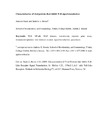| dc.contributor.creator | Stack, Julianne | |
| dc.contributor.creator | Bowie, Andrew G. | |
| dc.date.accessioned | 2019-02-26T12:19:27Z | |
| dc.date.available | 2019-02-26T12:19:27Z | |
| dc.date.issued | 2009 | |
| dc.identifier.citation | Stack J., Bowie A.G. (2009) Characterisation of Viral Proteins that Inhibit Toll-Like Receptor Signal Transduction. In: McCoy C.E., O’Neill L.A.J. (eds) Toll-Like Receptors. Methods in Molecular Biology™, vol 517. Humana Press, Totowa, NJ. | en_US |
| dc.identifier.uri | http://hdl.handle.net/10395/2677 | |
| dc.description | Characterisation of viral proteins that inhibit TLR signal transduction. | en_US |
| dc.description.abstract | Toll-like receptor (TLR) signalling involves five TIR adapter proteins, which couple to downstream protein kinases that ultimately lead to the activation of transcription factors such as nuclear factor-ĸB (NFĸB) and members of the interferon-regulatory factor (IRF) family. TLRs play a crucial role in host defence against invading microorganisms, and highlighting their importance in the immune system is the fact that TLRs are targeted by viral immune evasion strategies. Identifying the target host proteins of such viral inhibitors is very important because valuable insights into how host cells respond to infection may be obtained. Also, viral proteins may have potential as therapeutic agents. Luciferase reporter gene assays are a very useful tool for the analysis of TLR signalling pathways, as the effect of a putative viral inhibitor on a large amount of signals can be examined in one experiment. A basic reporter gene assay involves the transfection of cells with a luciferase reporter gene, along with an activating expression plasmid, with or without a plasmid expressing a viral inhibitor. Induction of a signalling pathway leads to luciferase protein expression which is measured using a luminometer. Results from these assays can be informative for deciding which host proteins to test for interactions with a viral inhibitor. Successful assays for measuring protein-protein interactions include co-immunoprecipitations (Co-IPs) and GST-pulldowns. Co-IP experiments involve precipitating a protein out of a cell lysate using a specific antibody bound to protein A/G sepharose. Additional molecules complexed to that protein are captured as well and can be detected by western blot analysis. GST pulldown experiments are similar in principle to Co-IPs, but a bait GST-fusion protein complexed to glutathione sepharose beads is used to pull down interaction partners instead of an antibody. Again, complexes recovered from the beads are analysed by western blotting. | en_US |
| dc.language.iso | eng | en_US |
| dc.publisher | Humana Press | en_US |
| dc.rights.uri | https://link.springer.com/protocol/10.1007%2F978-1-59745-541-1_14 | en_US |
| dc.subject | TLR | en_US |
| dc.subject | NF-kB | en_US |
| dc.subject | MAP kinases | en_US |
| dc.subject | Transfection | en_US |
| dc.subject | Reporter gene assay | en_US |
| dc.subject | Immunoprecipitation | en_US |
| dc.subject | Viral immune evasion | en_US |
| dc.subject | Signal transduction | en_US |
| dc.subject | Poxviruses | en_US |
| dc.title | Characterisation of viral proteins that inhibit TLR signal transduction (Pre-published version) | en_US |
| dc.type | Part/ Chapter of book | en_US |
| dc.type.supercollection | all_mic_research | en_US |
| dc.type.supercollection | mic_published_reviewed | en_US |
| dc.description.version | Yes | en_US |
| dc.identifier.doi | 10.1007/978-1-59745-541-1_14 | |


